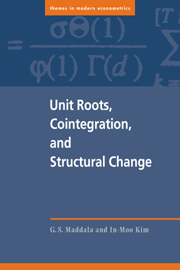Book contents
- Frontmatter
- Contents
- Figures
- Tables
- Dedication
- Preface
- Part I Introduction and basic concepts
- Part II Unit roots and cointegration
- 3 Unit roots
- 4 Issues in unit root testing
- 5 Estimation of cointegrated systems
- 6 Tests for cointegration
- 7 Econometric modeling with integrated regressors
- Part III Extensions of the basic model
- Part IV Structural change
- Appendix 1 A brief guide to asymptotic theory
- Author index
- Subject index
4 - Issues in unit root testing
Published online by Cambridge University Press: 04 August 2010
- Frontmatter
- Contents
- Figures
- Tables
- Dedication
- Preface
- Part I Introduction and basic concepts
- Part II Unit roots and cointegration
- 3 Unit roots
- 4 Issues in unit root testing
- 5 Estimation of cointegrated systems
- 6 Tests for cointegration
- 7 Econometric modeling with integrated regressors
- Part III Extensions of the basic model
- Part IV Structural change
- Appendix 1 A brief guide to asymptotic theory
- Author index
- Subject index
Summary
Introduction
In the preceding chapter we introduced some tests (ADF and Phillips- Perron tests) routinely used in testing for unit roots. There are, however, several problems with these tests – particularly their low power. In this chapter we discuss these problems and some solutions and alternatives that have been suggested, but are not wide spread in practice. The main issues that need to be discussed are:
(i) The low powers of unit root tests: what can be done to improve this?
(ii) The problem of over differencing and moving-average (MA) unit roots.
(iii) Use of instrumental variable (IV) methods (IV tests).
(iv) Using stationarity as null – rather than unit root as null.
(v) Devising more powerful tests.
(vi) Does frequency of observation matter (monthly versus quaterly data, quaterly versus annual data, and so on)?
(vii) Can we increase the sample size and power by using panel data (panel data unit root tests)?
(viii) What are the consequences of uncertainty about unit roots?
(ix) What are the appropriate significance levels to use on unit root tests? Isn't a unit root test a pre-test?
(x) Is 1(1) the only type of nonstationarity? What about tests for 1(0) versus I(d) with d > 0 but d ≠ 1.
(xi) What about a multivariate approach to unit root testing instead of the often used univariate approach?
Information
- Type
- Chapter
- Information
- Unit Roots, Cointegration, and Structural Change , pp. 98 - 154Publisher: Cambridge University PressPrint publication year: 1999
